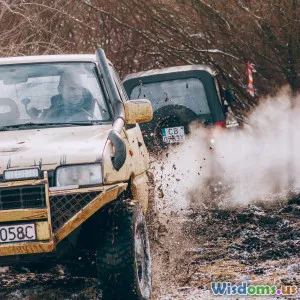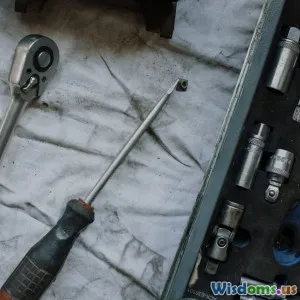
Five Common Mistakes When Building Off Road Rigs
8 min read Discover the top five pitfalls when building off road rigs and how to avoid them for a safe, capable, and enjoyable off-road experience. (0 Reviews)
Five Common Mistakes When Building Off Road Rigs
Building an off road rig is often a dream project for outdoor enthusiasts and vehicle hobbyists alike. The prospect of venturing deep into rugged terrain with a machine tailored to conquer dirt, rocks, mud, and streams is undeniably exciting. However, this endeavor can quickly turn frustrating—and expensive—if you fall prey to common mistakes that many builders encounter. From drivetrain miscalculations to suspension setup woes, these errors can limit your rig’s performance and durability.
This article explores five frequent mistakes people make when building off road rigs. With a combination of real-world examples, expert insights, and actionable advice, this guide arms you with the knowledge needed to avoid pitfalls and build a reliable, capable off road vehicle.
1. Overlooking Proper Suspension Design and Setup
A common misstep, especially among first-time off road builders, is neglecting the importance of suspension. The suspension keeps your rig stable over rough terrain by absorbing shocks and maintaining tire contact with the ground. Poor suspension choices can lead to a bumpy, unsafe ride and even long-term damage to your vehicle.
Key Issues:
- Choosing the wrong suspension components for your terrain and vehicle weight.
- Insufficient articulation limiting wheel travel, resulting in loss of traction.
- Using overly stiff or soft springs/recovery shocks that don’t complement the vehicle’s use.
Real-World Example: A builder who installed stock springs on a heavily modified Jeep Wrangler found that their rig bottomed out frequently during rock crawling. After upgrading to a coilover suspension designed for flex and articulation, the vehicle gained immense traction and safety improvements.
Expert Advice: Suspension expert and Jeep enthusiast Mark Fisher notes, "Balancing articulation with stability is key. You want enough flex to keep your tires on the ground, but also firm control to avoid vehicle sway and body roll."
Tips:
- Assess your vehicle weight and terrain type first.
- Research and select springs, shocks, and linkages designed for those parameters.
- Incorporate adjustable components where possible to fine-tune performance.
2. Ignoring Weight Distribution and Vehicle Balance
Many builders focus solely on upgrading parts without considering how weight is distributed throughout the vehicle. This oversight can lead to unexpected handling issues and reduced off road capability.
Why It Matters: Improper weight distribution can cause:
- Excessive front or rear bias, affecting steering and braking.
- Increased likelihood of rollovers on uneven land.
- Poor traction if weight isn’t balanced over tires.
Case Study: An off roader added large steel bumpers and a winch to their truck but didn’t relocate heavy accessories from the rear. The vehicle developed a front-heavy bias, making climbing steep inclines treacherous.
How to Avoid:
- Distribute heavy gear as low and centrally as possible.
- Use tools like portable scales to measure axle loads.
- Consider aftermarket components that reduce weight, like aluminum skid plates.
Industry Insight: An engineer for a leading off road parts manufacturer explains, "Many builders underestimate how accessories stack weight forward, which impacts climbing and descents negatively. Planning weight placement saves headaches later on."
3. Misguided Drivetrain Upgrades
Upgrading your drivetrain (axles, differentials, transfer case, and transmission) is fundamental for serious off road rigs. However, improper choices here can be costly and counterproductive.
Common Pitfalls:
- Fitting gears or axles not compatible with engine torque or tire size.
- Over-gearing tires causing transmission strain.
- Neglecting differential locks for difficult terrain.
Example: A builder who increased their tire size significantly and installed a third gear differential without changing gear ratios suffered drivetrain failures when tackling muddy trails.
Recommendations:
- Match gear ratios to your tire size and engine output.
- Invest in quality locking differentials for traction control.
- Consult technical charts or professionals to ensure compatibility.
4. Neglecting Safety and Recovery Equipment Planning
Experiencing a breakdown or getting stuck in remote locations can be dangerous. Yet many builders underestimate safety needs when customizing their off road vehicles.
Typical Oversights:
- Skipping the installation of reliable recovery points.
- Neglecting to install appropriate lighting for nighttime off roading.
- Forgetting redundant communication devices.
Data Point: According to the Outdoor Safety Institute, nearly 40% of off road emergencies are worsened by a lack of proper recovery equipment.
Pro Tip: Always include essential gear like D-rings on bumpers, rated winches, fire extinguishers, and at least one high-quality light bar or floodlight system.
Safety Specialist View: Sarah Collins, an off road safety trainer, remarked, "Successful off road rigs anticipate trouble and prepare for recovery. It saves time, money, and potential injuries."
5. Overcomplicating Modifications Without Purpose
The enthusiasm to build the ultimate off road rig sometimes leads to over-modifying with no clear plan or purpose.
Issues From Over-modifying:
- Increased maintenance complexity.
- Reduced reliability due to poorly integrated parts.
- Excessive weight and fuel consumption.
Example: A builder added multiple aftermarket electronic gadgetry without considering their power consumption or added weight. The results were drained batteries and frequent mechanical failures.
Best Practice:
- Define the main goals for your build — rock crawling, overlanding, mudding.
- Prioritize upgrades that directly enhance those activities.
- Keep it simple and built for reliability.
Thought-Provoking Quote: Famed off roader and builder, Jeff Wilson, states, "Sometimes the simplest rig wins. Complexity is the enemy of reliability in the wilderness."
Conclusion
Building an off road rig is as much an art as it is a science. Dough-to-skill mistakes are common but entirely avoidable with thoughtful planning and knowledge. From suspension tuning to weight management, drivetrain compatibility to safety foresight, every decision impacts your vehicle’s performance and safety.
Avoiding these five common traps not only saves you money and time but enhances your enjoyment and capability out on the trails. Take the lesson of experienced builders and approach your off road rig build with a clear purpose, careful research, and strategic choices. The open trail awaits your well-prepared machine.
Happy Trails and Safe Building!
Resources & Further Reading:
- Jeep Experts Suspension Guide, 2023 Edition
- Off Road Weight Distribution Basics, Outdoor Mechanics Journal
- Drivetrain Compatibility Charts – Offroad Tech Hub
- The Offroad Safety Handbook by Sarah Collins
- Minimalism in Off Road Builds, Adventure Magazine 2022
Rate the Post
User Reviews
Other posts in Off-Road Vehicles
Popular Posts















